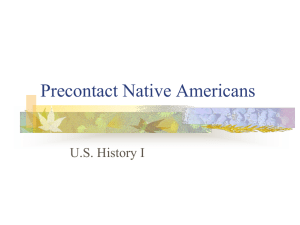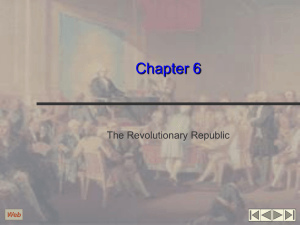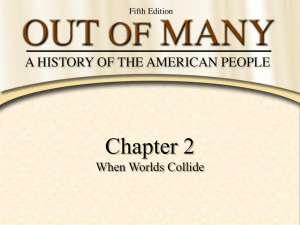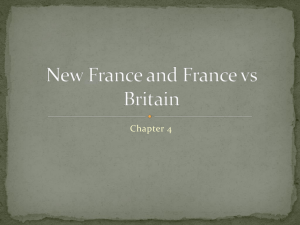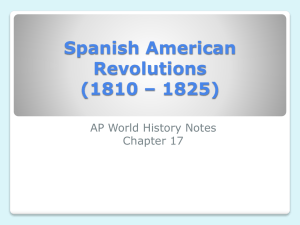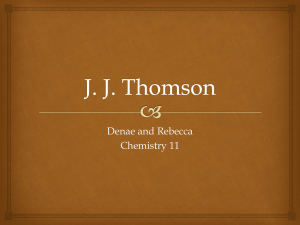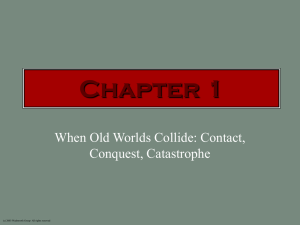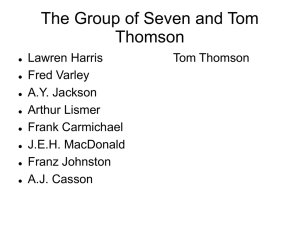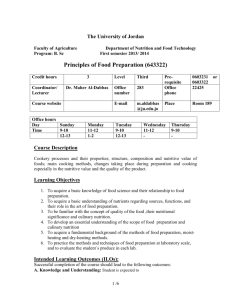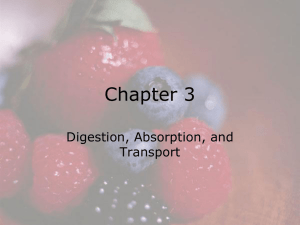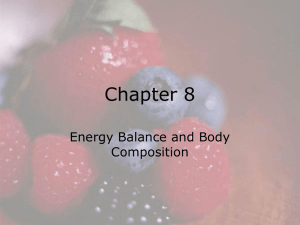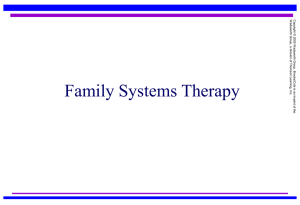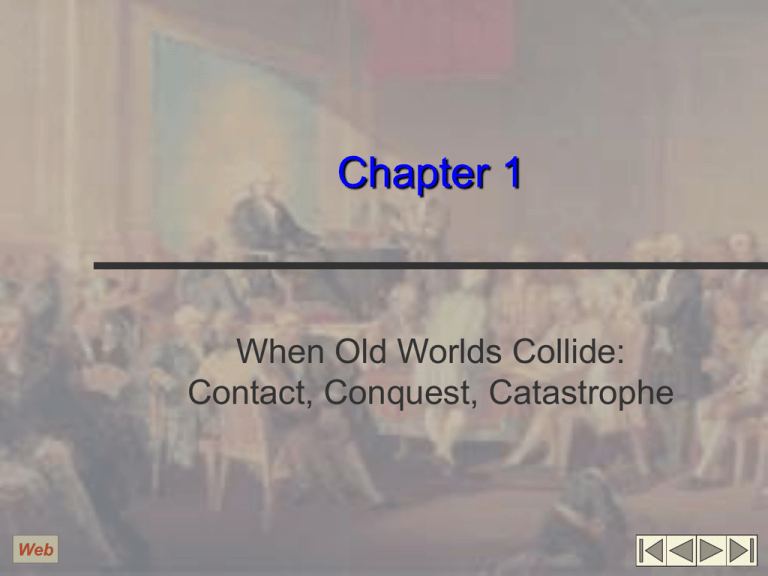
Chapter 1
When Old Worlds Collide:
Contact, Conquest, Catastrophe
Web
Peoples in Motion
Many people had migrated to North American
long before the European explorations
Beringia—Land bridge between Siberia and
Alaska
Home to generations and source of migration to
North America
Debate rages about exactly when migrants arrived
Probably arrived in three waves
First more than 14,000 years ago
Middle a few thousand years later
Last after 7,000 B.C.
Hunting/gathering Societies
Earliest migrants found a multitude of
animal species
Gradually
disappeared, largely due to over-
hunting
Sex segregated jobs within communities
Indian Women as Farmers
Appearance of Permanent
Farm Villages
Between 4000 and 1500 B.C.
Planned agriculture probably began with
women
Can be termed the Neolithic evolution
Norse exploration of North
American
First explored and occupied Iceland and
Greenland
Three explorations between A.D. 1001
and 1014
Established colony of Vinland, did not
last
Chinese Culture More Advanced in
Many Ways than Europe
Initiated many explorations of East Asia
between 12405 and 1434
Interest diminishes as China turned
toward thereafter
Convinced
that Chinese culture was
superior to rest of world
Europeans and Islamic World
Arab mariners best in world
Desired
access to East Indian spices
European resurgence came only after
Renaissance
Legacy from Crusades provided lessons
for greater European exploration
Portugal Emerged as Leader of
European Exploration Efforts
Role of Prince Henry and the crusading Order
of Christ
Leaders in technological innovation and
development
Involvement in slave trade
Exploited local rivalries among states of West and
Central Africa
Began search from water route to Asia in the
1480s
Established chain of naval bases but no real
settlements
©2004 Wadsworth, a division of Thomson Learning, Inc. Thomson Learning ™ is a trademark used herein under license.
Africa and the
Mediterranean
in the 15th
Century
Spanish Efforts to catch up to
Portugal after 1400
Really possible after marriage of
Ferdinand and Isabella in 1469
Spanish support for Christopher
Columbus
Sought
water route to Asia across Atlantic
Four voyages to the New World after 1492
Never realized he had discovered a New
World
Early Spanish Experience in
the New World
Brutal treatment of native population
Continued exploration throughout North
America
Engaged in search for great riches
Emergence of Sedentary and Semisedentary Cultures in the Americas
Native lives transformed by agriculture
after 4000 B.C.
Non-migratory societies only among
most advanced cultures
No individual ownership of land among
any Indian society
Regardless of size, Indian societies
remained Stone Age culture
Rise of Andean Civilization
Utilized ingenious irrigation systems for
high-altitude farming
Chavin, Mohica, Tiwanaku empires all
thrived
Inca Empire
Emerged abound A.D. 1400
Built capital at Cuzco, high in Andes
Mountains
Empire stretched 2,000 miles north to
south
No written language, yet controlled 8 to
12 million people by 1500
Cultures of Mesoamerica
Olmecs emerged along Gulf Coast around
1200 B.C.
Built small settlements of around 1,000 people
Constructed first pyramids and ballparks in
Mesoamerica
Utilized 52 year calendar system
Toetihuacan emerged in mountains outside of
present day Mexico City
Cultures of Mesoamerica (cont.)
City
has population of 40,000 by A.D. 1
Best known for brightly painted murals
Governed by a senate, not a monarch
Suddenly destroyed around A.D. 750
Mayans emerged in southern lowlands
of the Yucátan
Aztec Empire
Capital of Tenochtitlán in middle of Lake
Texcoco
Waged perpetual war to gain captives
for religious ceremonies
Made
many enemies among peoples of
Mesoamerica
North American “Mound Builders”
Three distinct cultures
New Ohio and Mississippi Rivers and
their tributaries
Thrived from 3000 B.C. to about a.D.
1700
Largest Mount at Cahokia near modern
St. Louis
©2004 Wadsworth, a division of Thomson Learning, Inc. Thomson Learning™ is a trademark used herein under license.
Mound Building
cultures of North
America
Southern Urban Cultures
Hohokam in central Arizona between 300
B.C. and A.D. 300
Sophisticated irrigation
Manufactured cotton cloth and distinctive red
pottery
Declined around 1450, likely due to water
shortages
Anasazi in New Mexico and Colorado
Cliff-dwelling-people
Flourished for two centuries, then declined in last
quarter of thirteenth century
Likely ancestors of Pueblo Indians
Early European-Indian Encounters
Revealed Many Differences
Christians unprepared to deal with native
societies
Troubled by Indian religious practices
Branded Indians Satan worshippers
Natives equally troubled by European
practices
Horrified by European executions of suspected
witches and other Europeans
Troubled by Communion rite in Christian churches
Widespread resistance to early Christianization
efforts
Early European-Indian Encounters
Revealed Many Differences (cont.)
Different conceptions of warfare
Europeans sought to slay as many of their enemies as
possible
Indians fought to acquire live captives
Europeans disliked Indian torture and ritual sacrifice of
captives
Indians appalled by European slaughter of women and
children
Indian societal organization differed markedly
from European
Most Indian societies were matrilineal and had clearly defined
social roles for men and women
Resisted Europeanization efforts because they challenged
their traditional social norms
The Spanish Conquest of
Mexico and Peru
Hernando Cortés invaded Aztec capital
of Tenochititlán in 1519
Seized
Emperor Moctezuma and replaced
Aztec religious images with Christian ones
Initial invasion no successful
Returned later with aid from the
Tlaxcalans, enemies of the Aztecs
Looted the city and established Mexico
City on its ruins
The Spanish Conquest of
Mexico and Peru (cont.)
Francisco Pizarro located Incas in 1531
Capitalized
on internal turmoil
Defeated much larger Incan force and
destroyed Cuzco
Established new capital at Lima on the
coast of Peru
Principal Spanish Explorations of North America
©2004 Wadsworth, a division of Thomson Learning, Inc. Thomson Learning™ is a trademark used herein under license.
Spanish Missionaries and Religious
Efforts in North American
Jesuits established mission in Virginia in 1570
Departed after Indian revolt
Franciscans replaced them North of Mexico
Royal Orders for New Discoveries, 15773
Made it illegal to enslave Indians or even attack them
Laid plans for unfortified missions headed by
priests to convert natives into peaceful Catholic
subjects of Spain
Some missionary success in northern Florida
and New Mexico
©2004 Wadsworth, a division of Thomson Learning, Inc. Thomson Learning™ is a trademark used herein under license.
Missions in Florida
and New Mexico,
circa 1675
The Spanish Empire in Practice
Ruled by direct control from Spain
Labor systems exploited natives
Empire and its riches transformed
missionaries
Became less concerned with saving souls as they
acquired land and laborers
Council of Indies established to choose New
World leaders
Power further consolidated after Portugal and
Spain joined in 1580 under rule of Philip II
Spanish Empire and Global Labor Systems
©2004 Wadsworth, a division of Thomson Learning, Inc. Thomson Learning™ is a trademark used herein under license.
Explanations for European
Conquest
Vast technological superiority
Steel most important
Biological effect of European diseases
devastating the Indians
European vegetation choked out native
plants
European animal prevailed over
potential American rivals
Web

